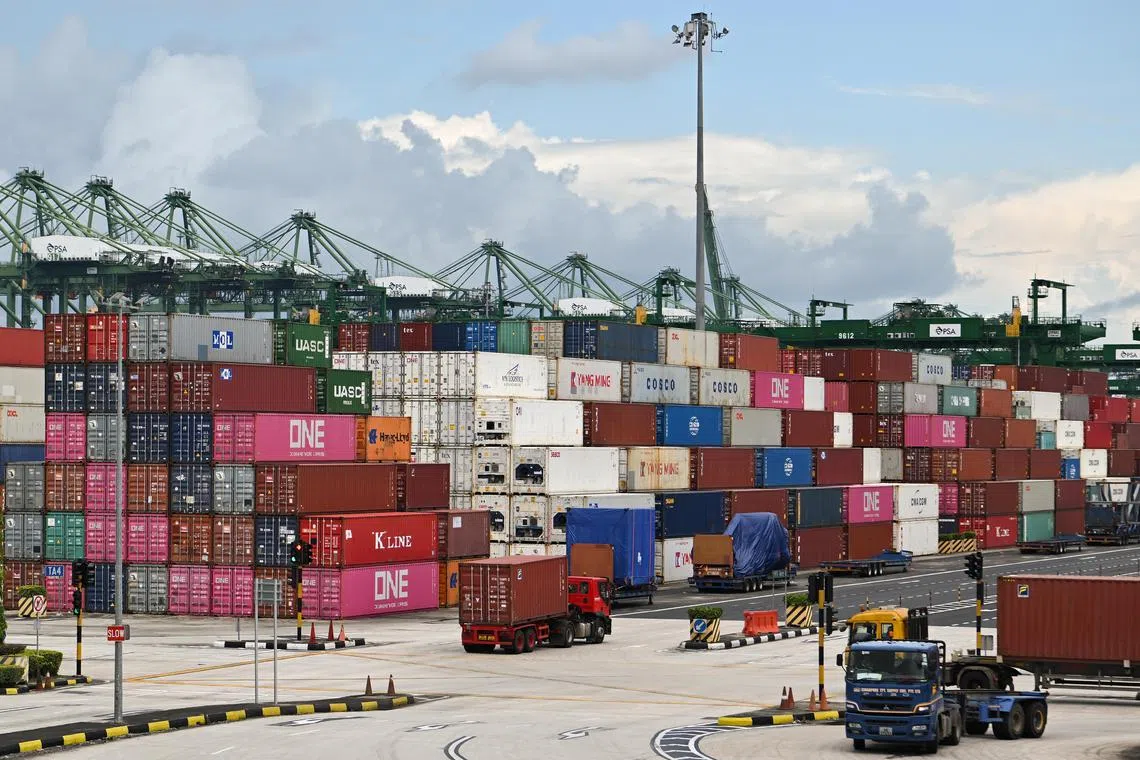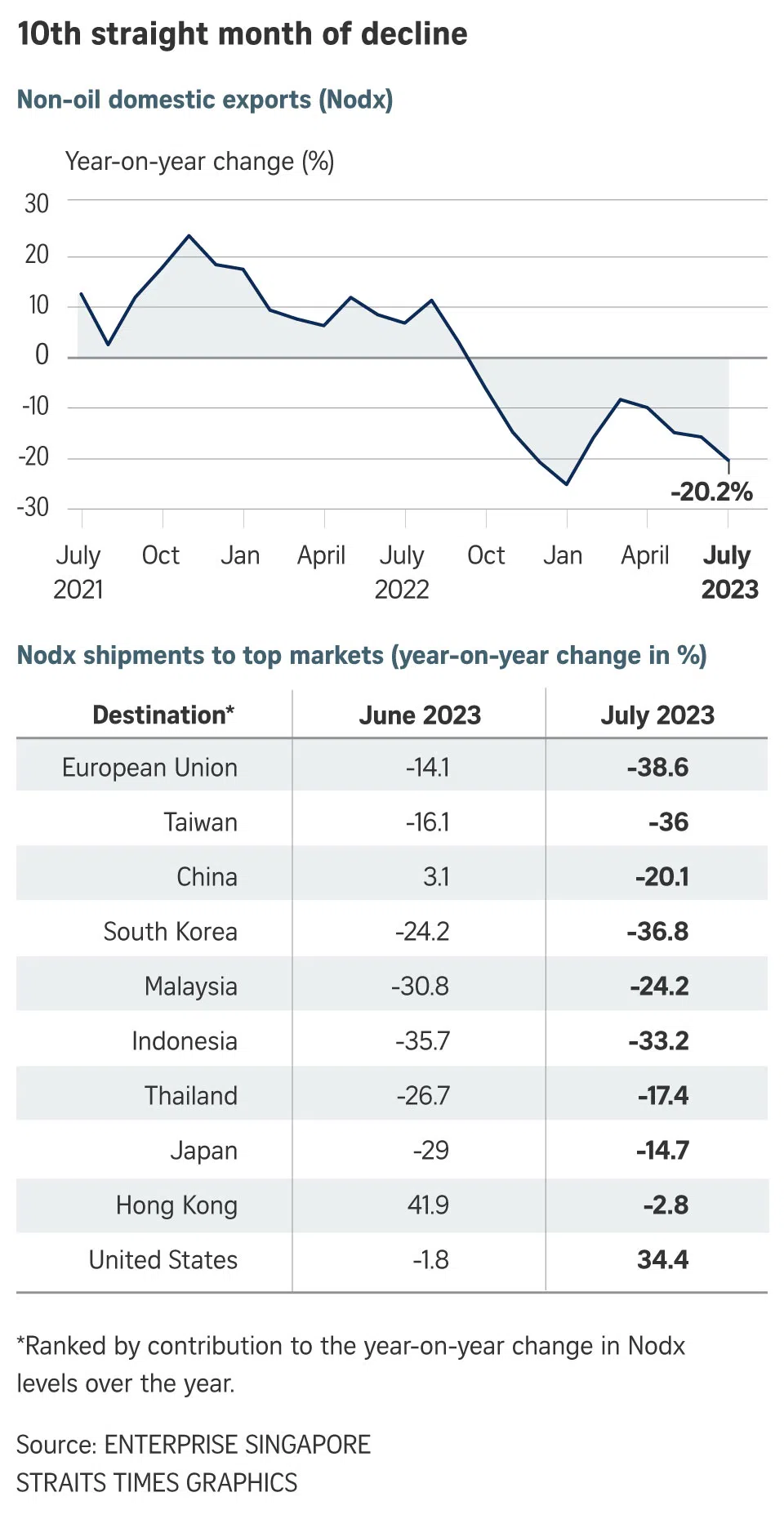Singapore trade slump worsens as key exports tumble 20.2% in July
Sign up now: Get ST's newsletters delivered to your inbox

Electronics shipments remained the biggest drag on July’s Nodx, tumbling 26.1 per cent compared with July 2022.
ST PHOTO: LIM YAOHUI
Follow topic:
SINGAPORE – The slide in Singapore’s key exports accelerated in July, with the trade slump extending for the 10th straight month and analysts seeing no recovery in the near term.
Non-oil domestic exports (Nodx) in July shrank 20.2 per cent compared with the same month in 2022, and contracted 3.4 per cent from June, data from trade agency Enterprise Singapore (EnterpriseSG) showed on Thursday.
This was worse than the 14.4 per cent contraction forecast in a Reuters poll of economists. It was also steeper than the revised 15.6 per cent fall in June.
On a month-on-month basis, July exports fell 3.4 per cent, reversing the 5.2 per cent rise in June.
Mr Louis Kuijs, chief Asia economist at S&P Global Ratings, told The Straits Times that exports from Singapore, like the rest of Asia, have been weak in recent months due to slowing demand in the United States and Europe, disappointing demand from China and a delay in the recovery of the semiconductor industry cycle.
“Moreover, falling prices of tradable goods weigh on export revenues in US dollar terms. Looking ahead, these factors are unlikely to improve soon. Thus, prospects remain subdued,” Mr Kuijs said.
Mr Chua Han Teng, an economist at DBS Bank, said Singapore’s trade is likely to remain in the doldrums in the near term, given the global headwinds.
But Mr Chua noted “some silver lining” hinting of a possible improvement in the year-on-year declines towards the end of 2023.
“On a seasonally adjusted month-on-month basis, Nodx for both electronics and non-electronics have stabilised over the past few months, while non-oil re-exports have increased over the past three months,” he said.
He noted that Singapore’s manufacturers are cautiously optimistic, with business sentiment for the second half of this year slightly positive.
“A similar picture is seen for electronics firms,” said Mr Chua, adding that this supports “a gradual improvement in shipments and production in the months ahead, alongside a turnaround in global semiconductor sales”.
Mr Alex Holmes, senior Asia economist at Oxford Economics, however, is less sanguine. He fears the recent month-on-month improvement cannot be sustained. While the US continues to outperform as an export destination, he warned that this may not last as the US is expected to slip into a shallow recession around the turn of the year.
“All told, the external environment that has been dragging on Singapore’s economy is unlikely to turn around quickly. While base effects mean the Nodx year-on-year growth numbers will look less scary by later this year, we don’t expect much improvement in level terms,” Mr Holmes said.

Electronics shipments remained the biggest drag on July’s Nodx, tumbling 26.1 per cent compared with July 2022.
Improvements in the export of telecommunications equipment could not offset the pronounced and prolonged soft patch in integrated circuits, disk media products and parts of integrated circuits.
Non-electronics exports shrank 18.5 per cent, dragged by non-monetary gold, specialised machinery and petrochemicals. They fell from the high base a year ago in July 2022.
Meanwhile, petrochemical exports dropped 23 per cent year on year on the back of refinery plant maintenance shutdowns and weak demand.
Shipments to most of Singapore’s top 10 markets shrank in July, except for the US, which took over from China as the Republic’s biggest export market.
Exports to China fell 20.1 per cent year on year, from a 3.1 per cent growth in June, due to weaker exports of integrated circuits, pharmaceuticals and petrochemicals.
Shipments to the European Union plunged 38.6 per cent due to a fall in pharmaceuticals, primary chemicals and specialised machinery.
Exports to Taiwan contracted 36 per cent, dragged by specialised machinery, integrated circuits and parts of integrated circuits.
Total trade contracted 20.8 per cent year on year, extending the 19.3 per cent drop in June.
Oil domestic exports shrank 37.4 per cent in July on lower exports to Malaysia, Indonesia and the EU.
Last week, Singapore downgraded its economic growth forecast to 0.5 per cent to 1.5 per cent,
It also cut again its 2023 growth forecasts for exports
Both Nodx and total merchandise trade are now expected to contract by 9 per cent to 10 per cent in 2023, due to a worse-than-expected performance to date, weighed down by the manufacturing down cycle and lower oil prices.


